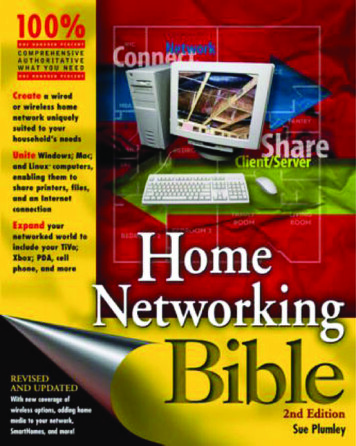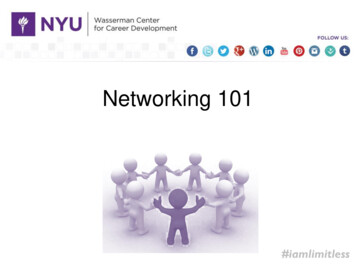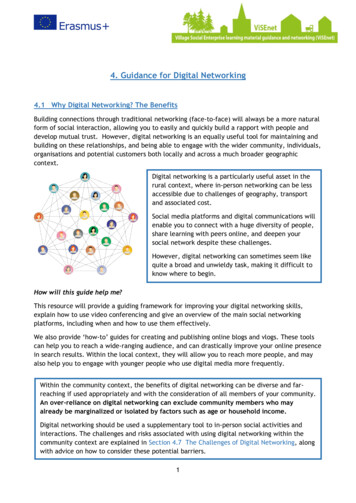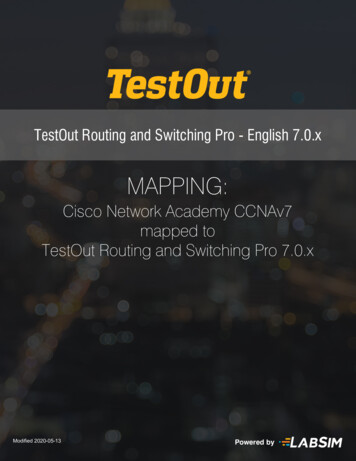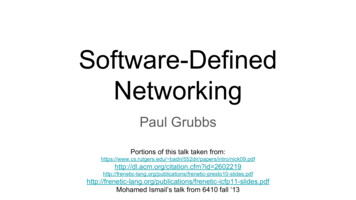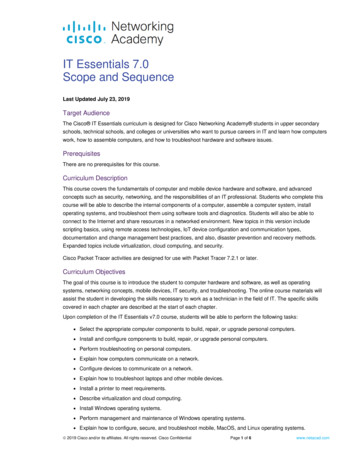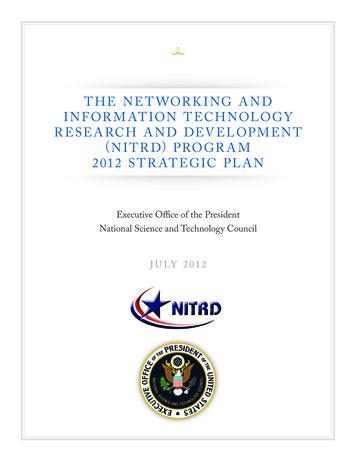
Transcription
T H E N E T WOR K I NG A N DI N F OR M AT ION T E CH NOL O G YR E SE A RCH A N D DEV E L OP M EN T( N I T R D) PRO GR A M2 01 2 S T R AT E GIC PL A NExecutive Office of the PresidentNational Science and Technology CouncilJ U LY 2 0 1 2
T H E N E T WOR K I NG A N DI N F OR M AT ION T E CH NOL O G YR E SE A RCH A N D DEV E L OP M EN T( N I T R D) PRO GR A M2 01 2 S T R AT E GIC PL A NExecutive Office of the PresidentNational Science and Technology CouncilJ U LY 2 0 1 2M A RCH 2012
About the National Science and Technology CouncilThe National Science and Technology Council (NSTC) is the principal means by which the ExecutiveBranch coordinates science and technology policy across the diverse entities that make up theFederal research and development enterprise. A primary objective of the NSTC is establishing clearnational goals for Federal science and technology investments. The NSTC prepares research anddevelopment strategies that are coordinated across Federal agencies to form investment packagesaimed at accomplishing multiple national goals. The work of the NSTC is organized under fivecommittees: Environment, Natural Resources and Sustainability; Homeland and National Security;Science, Technology, Engineering, and Math (STEM) Education; Science; and Technology. Each ofthese committees oversees subcommittees and working groups focused on different aspects ofscience and technology. More information is available at http://www.whitehouse.gov/ostp/nstc.About the Office of Science and Technology PolicyThe Office of Science and Technology Policy (OSTP) was established by the National Science andTechnology Policy, Organization, and Priorities Act of 1976. OSTP’s responsibilities include advisingthe President in policy formulation and budget development on questions in which science andtechnology are important elements; articulating the President’s science and technology policy andprograms; and fostering strong partnerships among Federal, state, and local governments, and thescientific communities in industry and academia. The Director of OSTP also serves as Assistant to thePresident for Science and Technology and manages the NSTC. More information is available athttp://www.whitehouse.gov/ostp.About the Subcommittee on Networking and Information TechnologyResearch and DevelopmentThe Subcommittee coordinates the multi-agency Networking and Information Technology Researchand Development (NITRD) Program to help: Assure continued U.S. leadership in networking and information technology Satisfy the needs of the Federal government for advanced networking and informationtechnology Accelerate development and deployment of advanced networking and informationtechnologyThis focus enables the United States to maintain world leadership in science and engineering,enhance national defense and national U.S. productivity and competitiveness and promote longterm economic growth, improve the health of the U.S. citizenry, protect the environment, improveeducation, training, and lifelong learning, and improve the quality of life. It also implements relevantprovisions of the High Performance Computing Act of 1991 (P.L. 102-194), as amended by the NextGeneration Internet Research Act of 1998 (P. L. 105-305), and the America Creating Opportunities toMeaningfully Promote Excellence in Technology, Education and Science (COMPETES) Act of 2007(P.L. 110-69). For more information, visit http://www.nitrd.gov/. ii
About this DocumentThis report was developed by the Subcommittee on Networking and Information TechnologyResearch and Development (NITRD) of the NSTC’s Committee on Technology. The report is publishedby the National Coordination Office (NCO) for the NITRD Program.Copyright InformationThis document is a work of the United States Government and is in the public domain (see 17 U.S.C.§105). Subject to the stipulations below, it may be distributed and copied with acknowledgment toNCO. Copyrights to graphics included in this document are reserved by the original copyright holdersor their assignees and are used here under the government’s license and by permission. Requests touse any images must be made to the provider identified in the image credits or to NCO if no provideris identified.Printed in the United States of America, 2012. iii
National Science and Technology CouncilChairStaffJohn P. HoldrenAssistant to the President for Science andTechnologyDirector, Office of Science andTechnology PolicyPedro I. EspinaExecutive DirectorCommittee on TechnologyChairStaffThomas C. PowerDeputy Chief Technology Officer of theUnited States for Telecommunications,Office of Science & Technology PolicyPedro I. EspinaExecutive SecretarySubcommittee on Networking and InformationTechnology Research and DevelopmentCo-chairsGeorge O. StrawnDirector, National Coordination Office forNetworking and Information TechnologyResearch and DevelopmentFarnam JahanianAssistant Director, Computer and InformationScience and Engineering DirectorateNational Science FoundationMembersBryan A. BiegelActing Deputy Division Chief, AdvancedSupercomputing DivisionNational Aeronautics and Space AdministrationJ. Michael FitzmauriceSenior Science Advisor for InformationTechnologyAgency for Healthcare Research and QualityAlan BlateckyDirector, Office of CyberinfrastructureNational Science FoundationMarilyn FreemanDeputy Assistant Secretary for Research &TechnologyArmyRobert ChadduckPrincipal Technologist for Applied ResearchNational Archives and Records AdministrationDouglas B. FridsmaDirector, Office of Standards and InteroperabilityDepartment of Health and Human ServicesOffice of the National Coordinator for HealthInformation TechnologyPedro I. EspinaProgram AnalystOffice of Science & Technology Policy v
Deborah A. FrinckeDeputy Director of ResearchNational Security AgencyDavid MichaudDirector, High Performance Computing &Communications OfficeNational Oceanic and AtmosphericAdministrationArti GargProgram ExaminerOffice of Management and BudgetKam NgDeputy Director of Research, Office of NavalRobert GoldResearchDirector, Information Systems and Cyber SecurityNavyOffice of the Secretary of DefenseCharles H. RomineDaniel A. HitchcockDirector, Information Technology LaboratoryAssociate Director, Office of Advanced ScientificNational Institute of Standards and TechnologyComputing ResearchDepartment of Energy, Office of ScienceVacantDirector, Center for Bioinformatics andCharles J. HollandComputational BiologySpecial Programs, Microsystems TechnologyNational Institutes of HealthOfficeDefense Advanced Research Projects AgencyGary L. WalterComputer Scientist, Atmospheric Modeling andDouglas MaughanAnalysis DivisionDivision Director, Cyber Security R&DEnvironmental Protection AgencyScience and Technology DirectorateDepartment of Homeland SecurityLt. Col. Dan WardChief of Acquisition InnovationRobert MeisnerAir ForceDirector, Office of Advanced Simulation andComputingStaffDepartment of Energy, National Nuclear SecurityVirginia MooreAdministrationExecutive Secretary vi
EXECUTIVE OFFICE OF THE PRESIDENTNATIONAL SCIENCE AND TECHNOLOGY COUNCILWASHINGTON, D.C. 20502July 1, 2012Dear colleague:American leadership in advanced digital technologies drove the communicationsrevolution that has transformed the world. In the global information age of the 21st century, ourNation must continue to lead in digital infrastructure and information technologies to provideessential foundations not only for our economic prosperity but also for addressing criticalnational challenges – such as strengthening national security and revolutionizing the energy,transportation, health care, and education sectors. That is why President Obama has set scientificand technological innovation, and support for the research and development that fuels it, as acentral priority of his Administration.This five-year strategic plan for the Federal Networking and Information TechnologyResearch and Development (NITRD) Program considers IT R&D in its broader societal context.It calls upon the Federal Government and private sector to work together to develop new, morepowerful kinds of partnerships between humans and digital devices; learn how to engineersystems and devices that earn society’s trust and confidence; and innovate in education for“cyber-capable” citizens and workers.The NITRD 2012 Strategic Plan is a vital building block in the Administration’s Strategyfor American Innovation, illuminating ways in which cutting-edge Federal R&D in digitaltechnologies, infrastructure, and capabilities can promote competitive markets that spurentrepreneurship, promote job growth, and catalyze breakthroughs for national priorities. ThePlan also supports the priorities identified by the President’s Council of Advisors on Science andTechnology in its 2010 review of the NITRD Program, including health care, energy, andtransportation empowered by advanced networking and information technologies and a robustand secure cyber infrastructure.I look forward to working with Federal agencies and the private sector to ensureimplementation of this plan.Sincerely,John P. HoldrenAssistant to the President for Science and TechnologyDirector, Office of Science and Technology Policy
Table of ContentsExecutive Summary . . . . . . . . . . . . . . . . . . . . . . . . . . . . . . .1I. Introduction . . . . . . . . . . . . . . . . . . . . . . . . . . . . . . . . . . 3A. Advancing Our National Priorities . . . . . . . . . . . . . . . . . . . . . . . 3B. NITRD Vision . . . . . . . . . . . . . . . . . . . . . . . . . . . . . . . . 4C. The Vision’s Three Essential Foundations . . . . . . . . . . . . . . . . . . . . 5D. The Challenge of Accelerating IT Change . . . . . . . . . . . . . . . . . . . . 6Why We Have Reached a Pivotal Transition . . . . . . . . . . . . . . . . . . . . . . . 6II. Three Essential Foundations of IT R&D . . . . . . . . . . . . . . . . . . . . . . . 9A. WeCompute . . . . . . . . . . . . . . . . . . . . . . . . . . . . . . . . 9Making the Digital World Accessible to Everyone (A7) . . . . . . . . . . . . . . . . . . 11Accelerating the Future of Computing . . . . . . . . . . . . . . . . . . . . . . 12Evolving and Scaling Socio-Technical Network Infrastructure . . . . . . . . . . . . . 13Creating the Smart Planet . . . . . . . . . . . . . . . . . . . . . . . . . . 15Engineering Complex and Sophisticated Software . . . . . . . . . . . . . . . . . 16From Data to New Knowledge . . . . . . . . . . . . . . . . . . . . . . . . . 17Pioneering Socially Intelligent Systems . . . . . . . . . . . . . . . . . . . . . 19B. Trust and Confidence . . . . . . . . . . . . . . . . . . . . . . . . . . . . 20Making the Digital World More Trustworthy . . . . . . . . . . . . . . . . . . . 20Securing Life in Cyberspace . . . . . . . . . . . . . . . . . . . . . . . . . . 21Systems You Can Bet Your Life On . . . . . . . . . . . . . . . . . . . . . . . 22Information Assurance and Sharing . . . . . . . . . . . . . . . . . . . . . . 23Understanding the Trade-offs: Balancing Security and Privacy With Other Values . . . . . 24C. Cyber Capable . . . . . . . . . . . . . . . . . . . . . . . . . . . . . . . 25A Workforce of Cyber Innovators . . . . . . . . . . . . . . . . . . . . . . . . . . . 25The Education of Cyber-Capable Citizens . . . . . . . . . . . . . . . . . . . . . 26Technologies to Empower 21st Century Learning . . . . . . . . . . . . . . . . . . . . 27 ix
T H E N E T WO R K I N G A N D I N F O R M AT I O N T E C H N O L O G YR E S E A R C H A N D D EV E L O P M E N T ( N I T R D ) P R O G R A M 2 0 1 2 S T R AT E G I C P L A NIII. Transforming Challenge Into Strategic Opportunity . . . . . . . . . . . . . . . . 29A. The Federal Role . . . . . . . . . . . . . . . . . . . . . . . . . . . . . . 29Collaboration in Support of Mission Requirements . . . . . . . . . . . . . . . . . . . 29Infrastructure for Leadership . . . . . . . . . . . . . . . . . . . . . . . . . . . . 29B. Partnership Synergies Are Essential . . . . . . . . . . . . . . . . . . . . . . 30Notes . . . . . . . . . . . . . . . . . . . . . . . . . . . . . . . . . . . . . 33 x
Executive SummaryInformation technology (IT)—computers, wired and wireless digital networks, electronic data andinformation, IT devices and systems, and software applications—today provides indispensableinfrastructure for activities across all facets of society. Throughout the IT revolution, the United Stateshas led the world in the invention and applications of these technologies. Ongoing research anddevelopment (R&D) to provide advanced IT capabilities for Federal missions has fueled the creationof new ideas, and innovations addressing key national priorities, including national security, nationaldefense, economic prosperity, scientific discovery, energy and environment, health, individualprivacy, and quality of life.This five-year strategic plan for the Federal government’s Networking and Information TechnologyResearch and Development (NITRD) Program responds to recommendations of the President’sCouncil of Advisors on Science and Technology (PCAST). In “Leadership Under Challenge: InformationTechnology R&D in a Competitive World,” its August 2007 assessment of the NITRD Program, thePCAST recommended that NITRD “develop, maintain, and implement a cohesive strategic plan” thatincludes “a comprehensive technology vision and strategy that identify the next generation andfuture generations of important networking and information technology challenges and describehow to meet those challenges.”1This NITRD strategic plan presents an overarching vision for the digital world in the 21st century—aworld in which high-speed networks, systems, software, devices, data, and applications are fullysecure, safe, reliable, multimodal, and easy to use. In the envisioned future, next-generation ITinfrastructure and capabilities will enable continued U.S. leadership in economic innovation, scientificdiscovery, national security, education, and quality of life.To realize the NITRD vision, this plan calls for advancing U.S. capabilities in three broad areasidentified as the essential foundations for sustained leadership in a digital world:WeCompute—Expanded human-computer partnerships, including more capable, available, andaffordable systems; more powerful digital tools for people; and new forms of collaboration betweenthe two.Trust and Confidence—The ability to design and build systems with levels of security, safety, privacy,reliability, predictability, and dependability that “you can bet your life on.”Cyber Capable—Transformed education and training to ensure that current generations benefit fullyfrom cyber capabilities and to inspire a diverse, prepared, and highly productive next-generationworkforce of cyber innovators.This plan discusses the topical elements of each foundation and summarizes the principal researchand education challenges that need to be addressed, providing a comprehensive research andeducation strategy for building a bright American future. The plan concludes that the NITRDProgram should pursue expanded multiagency collaboration; cultivate new forms of partnershipwith academia and industry; and continue to lead by example in multidisciplinary activities andidentification of critical-path research needs. 1
T H E N E T WO R K I N G A N D I N F O R M AT I O N T E C H N O L O G YR E S E A R C H A N D D EV E L O P M E N T ( N I T R D ) P R O G R A M 2 0 1 2 S T R AT E G I C P L A NThe actions and associated resources required to implement the goals of this plan will need to beprioritized in the context of other U.S. Government priorities. This document is not intended as aninherent justification to seek increased budgetary authority. We believe that the goals and objectivesmay be achieved through reprioritization and reallocation of existing resources. It is expected thatdepartments and agencies will consider this document in their internal prioritization and planningprocesses. 2
I. IntroductionA. Advancing Our National PrioritiesRapid change is often cited as the only constant in networking and IT. After all, in only a few decades,IT systems have evolved from relatively rudimentary “dinotech” to futuristic electronic marvels thatenable people the world over to communicate, access information, and compete using a device thatfits in the palm.In fact, there has been another constant throughout the IT revolution: U.S. leadership in the inventionof digital technologies. As a result of that leadership, IT has significantly enhanced the Nation’seconomy, quality of life, and national security. Ongoing Federal R&D to provide the world’s mostadvanced IT capabilities for U.S. government missions has fueled the creation of new ideas, andinnovations that have enabled the United States to address key national priorities. For example: Economic prosperity—new multibillion-dollar IT industries have arisen from R&Dbreakthroughs; communications technologies and standards make possible vibrante-commerce, more efficient business-to-business interactions, and improved industrialprocess control systems Quality of life—advances in communications standards, electronics, and the Internet havespurred an explosion of novel social networking and web applications with millions ofparticipants, enabling people to collaborate effectively over great distances National security and defense—digital capabilities have transformed strategiccommunications and reduced battlefield risk for military personnel Health and health care—IT makes possible skilled on-site medical care, in the home and atremote locations Energy and environment—sensors and high-fidelity modeling and simulation enable betterenergy efficiency and weather and climate-change prediction, and speed development ofrenewable energy sources Education and training—learners of all ages now have on-demand access to vast educationand knowledge resources Open and transparent government—rapidly growing electronic access systems areopening government information and participation to the public and increasing efficiency ingovernment servicesThis five-year strategic plan for the NITRD Program looks beyond the immediate IT landscape towardlonger-term transformational impacts of digital technologies (and their yet-to-be-discoveredsuccessors) on society and the world. The plan proposes three new concepts that the NITRD agenciesview as essential foundations for maintaining U.S. technological preeminence in the dynamic eraahead. The plan also identifies the advances needed in IT research and education that will enable theUnited States to build these foundations and reap their economic and societal benefits. 3
T H E N E T WO R K I N G A N D I N F O R M AT I O N T E C H N O L O G YR E S E A R C H A N D D EV E L O P M E N T ( N I T R D ) P R O G R A M 2 0 1 2 S T R AT E G I C P L A NB. NITRD VisionThe NITRD strategic plan begins with a vision of the digital future.High-speed networks, systems, software, devices, data, and applications are fully secure, safe, reliable,multimodal, and easy to use. This ultra-high-bandwidth infrastructure—including both flexible,mobile wireless and hard-wired connectivity—is always available, ubiquitous, and can be activatedwhen needed; it is affordably accessible to anyone, anywhere, anytime. Information shared over theinfrastructure is completely secure; user privacy and confidentiality can be assured on demand; andpervasive repositories provide for archiving and retrieving data in perpetuity. In the all-encompassingdimension called cyberspace, people—unfettered from constraints of time, circumstance, and location—partner with computing devices and their capabilities to learn, imagine, discover, play, create, invent,interact, and collaborate in real time in ways that enhance life and generate solutions for the world’s mostcomplex problems.Imagine, for example, that:Energy becomes renewable, affordable, and non-polluting, and the United States leads globally inproduction and applications of advanced energy technologies. How? Data-intensive scientific computation combines with human creativity to acceleratediscoveries leading to new mechanisms for producing energy and new alternative energysources, clean production and distribution technologies, and eco-friendly synthetic fuels “Intelligent” distribution networks seamlessly control and manage the integration, flow,storage, and efficient distribution of electricity from all energy sources to “smart” end-usersystems that empower consumers to maximize conservation and eliminate energy leaks andwaste The new U.S. energy-technologies sectors provide technically skilled jobs in energyproduction; transportation and power-infrastructure manufacturing and maintenance; andsupply chain and servicesAffordable, high-quality, patient-centric health care is accessible to anyone of any age, anywhere, andanytime. How? Individuals possess secure, privacy-protected digital health profiles—with physiologicaland genetic data as well as medical history, treatment contra-indications, and the like—sothey can receive personalized medical attention whenever and wherever they need it,while reducing the costs in time and paperwork of providing care; virtual private networkcapabilities in the home and throughout the community make possible real-time,confidential patient-doctor consultations including examination and diagnostic services thatsave time and effort for both the patient and the physician The elderly and the chronically ill are able to live independently, supported by smart assistivedevices and always available, interactive network connectivity with family, friends, andcaregivers 4
I . I ntrod u ction Medical errors are reduced because medical devices, often integrated in networked “plugand-play” systems of systems, perform with very high reliability and accuracy, and the smartmedical networks enable constant monitoring of system performance, alerting personnelinstantaneously to anomalies and assuring continued functionality under adverse conditions Computational genetic and biomolecular analyses enable researchers to develop techniques,customized to the individual, to prevent the onset of disease or provide cost-effective earlydetection and personal treatment plansPeople enjoy increased security, educational and economic opportunity, and quality of life. How? Cyber national security capabilities reduce the risk of cyber warfare affecting major economicsectors and critical infrastructures connected to the cyber infrastructure; digital defensesystems reduce battlefield risks and casualties by orders of magnitude from today’s levels IT supports a national ecology of innovation that enables us to invent, make, and build novelartifacts that generate new economic opportunities, technology-based industries, and jobsthat strengthen U.S. global science and technology leadership High-speed communications and computation infrastructure enables large-scale distributedwork environments, reducing the need for commuting and thus urban congestion andpollution The self-managing and “unbreakable” broadband cyber infrastructure enables rapid, efficientprocesses in every sector, eliminating costly, labor-intensive defensive measures and repairsto networks and systems while enabling advanced emergency-response communicationsnetworks whenever and wherever they are needed Intelligent systems help manage accident-free transportation on the ground and in the air,and perform a wide range of physical and intellectual tasks at all scales—from home choresto precision noninvasive surgery to massive ultra-speed calculations and data analyses thatenhance human problem-solving and decision-making Teaching, learning, and knowledge environments are virtually universal, making theexcitement of discovery an integral part of life from cradle to graveC. The Vision’s Three Essential FoundationsThis plan argues that the keys to this future of promise will be held by those who successfully developits three essential foundations. WeCompute, the first foundation highlighted in the NITRD StrategicPlan, identifies the technological direction of the 21st century toward closer, more productivepartnerships between people and computing systems, including their data resources. Trust andConfidence identifies fundamental attributes that must be assured in the information technologiesupon which society increasingly depends, and Cyber Capable describes the role of education andtraining in preparing citizens and workers for the cyber future. The NITRD agencies believe all threefoundations (summarized below) must be developed to make possible the visionary advances in 5
T H E N E T WO R K I N G A N D I N F O R M AT I O N T E C H N O L O G YR E S E A R C H A N D D EV E L O P M E N T ( N I T R D ) P R O G R A M 2 0 1 2 S T R AT E G I C P L A Nscience and technology that will keep the United States at the forefront of economic prosperity,innovation, and scientific leadership.WeCompute—new understandings and technologies that expand and exploit the intellectualand creative potential of synergy between humans—from individuals to large-scale groups—andcomputing systems and data. Deepening this dynamic partnership will enable new levels ofintelligence, intuition, and awareness emerging as greater than the sum of the parts in the union ofcyber, human, and social capabilities. The artifacts we engineer and manufacture will increasinglymeld digital, physical, and cognitive attributes in unprecedented ways that enhance the quality of lifeand extend the frontiers of discovery, innovation, and achievement.Trust and Confidence—the ability to design and build systems with levels of security, safety, privacy,reliability, predictability, and dependability that “you can bet your life on,” and an understandingof “the science of security” that will enable us verifiably to create systems we can trust out offundamentally untrusted (whether by accident or by design) components. Cyber systems that inspiretrust and confidence will greatly increase their value to society, and will ensure that data resourcesand systems can be reliably used for their intended purposes.Cyber Capable—transformed education and training to ensure that current generations benefit fullyfrom cyber capabilities and to inspire a diverse, prepared, and highly productive next-generationworkforce of cyber innovators.Today, we are far from having these foundations for the future in place. Subsequent sections of thestrategic plan discuss each foundation in more detail, summarizing the current state of the art andpointing to key areas of research, development, and education in which Federal resources and policyattention will be needed in order to realize the NITRD vision.D. The Challenge of Accelerating IT ChangeWhy We Have Reached a Pivotal TransitionComputers, wired and wireless digital networks, electronic data and information, IT devices andsystems, and software applications form the indispensable infrastructure for activities across all facetsof society, driving innovation in every sector. Only a few technologies in human history have had suchprofound global impacts, and none as rapidly; yet the digital age has barely begun.Even so, because the rate of technological change is accelerating exponentially, we are now hurtlinginto the all-digital future. In 1999 there were fewer than 300 million cell phone subscribers worldwide.Today, there are almost as many cell phone subscriptions as people on the planet, and the volumeof wireless Internet traffic is expected to keep soaring as new applications appear. Google statisticstallied a billion unique World Wide Web pages in 2000; in July 2008, the figure passed the one-trillionmark. Today’s federally sponsored peta-scale systems can complete in an hour a computation thatwould have taken more than 100 years for a supercomputer of two decades ago. Other exponentialchanges—such as the radically shrinking cost per megabyte of storage and per megabit ofbandwidth—are speeding the emergence of global social networks, Web services, and the new formof shared distributed computing and storage resources called cloud computing. 6
I . I ntrod u ctionCascading growth in types and quantities of digital devices and applications, along with decreasingcost and size per unit, ultimately will generate fundamental, worldwide changes in the quality of lifeand the speed of innovation. The NITRD strategic plan illuminates this pivotal time of transition andassesses its implications for U.S. R&D. 7
II. Three Essential Foundations of IT R&DWhere We Need to Go From HereThe focus of the digital age thus far has been on its novel machinery. Now attention must turn topeople and the integrated and seam
includes "a comprehensive technology vision and strategy that identify the next generation and future generations of important networking and information technology challenges and describe how to meet those challenges." 1 This NITRD strategic plan presents an overarching vision for the digital world in the 21st century—a





